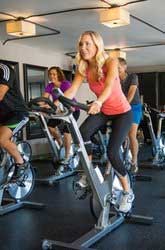April 2016 Indoor and Outdoor Cycling Drills
 To maxium and optimize your training and fitness IndoorCycling.ca decided to offer you the following training techniques. Thank you for sharing this post. Cheers.
To maxium and optimize your training and fitness IndoorCycling.ca decided to offer you the following training techniques. Thank you for sharing this post. Cheers.
1. Cycling Technique – Horizontal Pedaling
Don’t think about the pedal stroke as being up and down or even circular. Think of it as horizontal; at the top and bottom of the stroke your legs are transitioning to go the other direction – either forward and down or back and up. An increase in energy output here decreases the need for a very high effort at 3 o’clock. There are several elements of the stroke you can focus on to develop this horizontal pedaling skill. The best mental focus for most riders involves driving the toes toward the ends of their shoes at the top of each stroke. Another mental cue that works for some is scraping mud off at the bottom. Yet a third involves imagining that you are throwing your knees over the handlebars. Concentrate on one of these at a time.
2. Cycling Technique – Isolated Leg
Make sure you’re properly warmed up before starting drill work. While riding on an indoor trainer, place a chair or stool on each side of the bike. Place one foot on the chair or behind you on the trainer support and pedal with the other for 30 seconds, focusing on smoothing out that leg’s directional changes at the top and bottom of the stroke. Then switch legs and pedal for 30 seconds with the other, focusing on the same good technique. Keep your cadence at around 90 rpm throughout. After working both legs, pedal normally for another minute with both legs, sustaining the same sensation of proper technique
3. Cycling Technique – Pedal Recovery
What you do with the leg that is on the recovery side of the stroke is critical to your economy. If this leg rests on the pedal, the other leg will have to work harder to lift it. Be careful not to pull up with the recovery leg (except when climbing or sprinting) because this will cause a tremendous waste of energy. Instead, try to simply “unweight” the recovery pedal. In other words, if you weren’t clipped in, the weight of that leg would be taken off the pedal as it came back up. In reality, this won’t happen because of the centrifugal force of pedaling, but we can always move closer to this ideal. Practice this drill on the road or on an indoor trainer.
4. Cycling Technique – Spin-ups
This drill helps you become more economical at higher cadences. Either on the road or on an indoor trainer, while riding in a low gear, gradually increase your cadence over a 30-second period until you begin to bounce on the saddle. Then slow the cadence until you are no longer bouncing and hold this for a few more seconds. The key to this drill is relaxation. Relax your toes, your grip on the handlebars, and your face. Make it seem almost effortless. Do several of these within a ride, separating them with a few minutes of “normal” cadence.
5. Cycling Technique – Toe Touch
This is a “mind” drill designed to get you to focus on your feet while pedaling. Every time your foot approaches the top of the stroke, imagine that you can push your foot forward in your shoe, touching your toes to the front end of your shoe. Of course, you won’t be able to do this, but trying so will cause you to transition more smoothly through the 12-o’clock position. Pedal in an easy gear, going slowly as you learn how to make this movement. As you master the drill you’ll be able to turn the pedals faster.
Posted by Johnny Zakharia Vancouver
